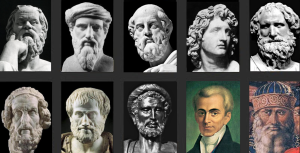
Philosopher, Mathematician, Physicist, Engineer, Inventor, Astronomer, Statesman, Strategist, Musician (428 BC – 347 BC)
Archytas was a Pythagorean philosopher and polymath, one of the brightest minds το ever pass from Greek history. He built and flew the first flying machine in recorded history.
His contributions are numerous and expand in many different fields. As a Pythagorean philosopher, he expressed innovative ideas concerning learning and education. He believed that learning derived from the methodology of transmitting knowledge to others and by means of creative discovery. Among his most notable students was Eudoxus of Cnidus and Plato, who later became one of his closest friends. He was head of the Pythagorean school of philosophy in Tarentum.
As a general, Archytas was elected 7 times consecutively, even though re-elections were prohibited and was never defeated in battle. This comes to show how skilful he was in politics and how he could apply his philosophical thinking in the governing of a city-state. Indeed, he was a very close friend of Plato, having rescued him when he was on a journey to Syracuse. It is believed that the idealized Philosopher-King whom Plato is referring to in the Republic is Archytas, or at least, a ruler with Archytas’ virtues.
As member of the Pythagorean brotherhood, Archytas was one of the most special philosophers of his times, considering the fact that only the most virtuous men and women were handed down the Pythagorean teachings. Archytas has the following prerequisites for someone to become wise. First, they must have been born with a spirit gifted with the capacities of understanding, memory and work. Second, they must have exercised their intelligence from a young age with mathematics. Third, they must meditate (Διαλογισμός) to reach the divine knowledge of the universal laws of nature and humanity. This undertaking requires the soul to be brave, persistent, prudent, mnemonic and to research everything.
Since at that time Music was considered as a branch of Mathematics, Archytas made numerous innovations in the field. As a Harmonic Theorist, he discovered that the fundamental intervals of music could be illustrated as ratios on a string length. According to Plato, he made enormous contributions to music, most than any other Pythagorean, to an extent where he took music as a science to a whole new level.
Archytas’ major contributions to humanity were in the field of mathematics. He solved the Delian Problem, the so-called Doubling of the Cube and founded Mechanics as a science in Physics. Many of his discoveries were later included in Euclid’s magnum opus Elements. He also made decisive contributions in Geometry, the Theory of Numbers, Optics and Logistics.
In addition to being a mathematician, Archytas was a prolific inventor. He invented the toy rattle, the pulley and the screw but his most magnificent invention of all was the world’s first flying machine. It was termed Peristera or Pigeon because of its shape. It was constructed by wood and an intricate system which utilized compressed air or steam to propel it into the air. The machine flew approximately 200 meters on its first flight, 179 meters more than the first flying machine of the Wright Bros. in 1903.
Archytas was one of the leading mathematicians of the ancient world, equal to Euclid and Pythagoras. Even though most of his work has been lost, the one that remains today is still sufficient enough to be regarded as monumental and for him to be considered one of the greatest polymaths in world history. Without his inventions, there wouldn’t exist today anything from a steam engine to an entire factory.
Bibliography
- “Archytas o Tarantinos”. Helios New Encyclopaedic Dictionary. Passas, I. Athens: 1946. Print.
- Ayfantis, Georgios. Anthropos & Epistimi – Enimerosis: Prehistory and History of Man, Science & Civilization. Athens: Hellinikon Selas, 2009. Print.
- Kotsanas, Kostas. Ancient Greek Technology: The Inventions of the Ancient Greeks. Pyrgos: Kostas Kotsanas, 2013. Print
- Sakellariou, Georgios. Pythagoras the Teacher of the Centuries. Ideotheatron: Athens, 1963. Print.
- The Editors of Encyclopaedia Britannica. ”Archytas” Encyclopaedia Britannica. Web. 3 Oct. 2015.

[…] influential musical theorists are presented such as those of Plato, Eudoxus, Aristoxenos and Archytas. Astronomy comprises the larger part of Theon’s work. He measured the diameter of the Earth, […]
LikeLike
[…] Pythagorean School of philosophy in Thebes and Phlious. Upon returning to Tarentum, he initiated Archytas into Pythagoreanism, who in turn initiated Plato. Furthermore, two students of Philolaus, Simmias […]
LikeLike